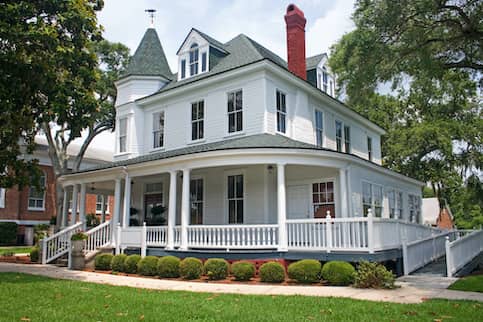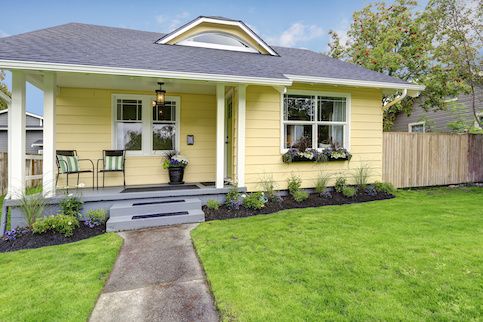The History Of Mortgages In The American Housing Market

Most people understand the basic function of a mortgage. In short, a mortgage agreement allows you to borrow the money needed to purchase a home, which is then repaid to the lender with interest. But where did mortgages come from and how have they changed over time?
When Did Mortgages Start?
Home mortgages as we know them were first introduced into the American housing market in the 1930s, though the concept of a mortgage can be traced back much further. References to mortgages can be found among remnants of ancient civilizations, when a “mortgagor” – or what we would now refer to as a lender – would agree to exchange property with a borrower if they pledged to repay it over time.
But although mortgages as a concept have stood the test of time, the mortgage you might have encountered a century ago is drastically different from what exists today. European countries had earlier versions of money-lending practices that were later implemented by the U.S., but how did these practices turn into the modern mortgage? Keep reading to find out.
See What You Qualify For
Home Purchase
Home Refinance
Tap Into Equity
The History Of Mortgages In America: A Timeline
Late 1800s: Balloon Mortgages Due To Increased Housing Demand
As people began to immigrate to the U.S. in droves in the late 1800s and early 1900s, the American housing market began to shift, leading to a dramatic increase in demand for affordable housing, and by extension, mortgages.
As of the early 1900s, home buyers were still required to make a hefty 50% down payment on their home purchase, often with only a 5- or 6-year amortization period. During this time, borrowers would make interest-only payments, followed by a large balloon payment of the remaining loan balance during the final month of repayment.
But the short repayment timeline and large down payment requirements effectively gatekept homeownership, making it only an attainable reality for the wealthy. This meant most people simply didn’t own property or ended up buying their homes outright if they were affluent enough to do so.
1920s: The Great Depression
The appeal of affordable, interest-only mortgage payments led to more buyers financing homes throughout the 1920s – but the small payments were often deceiving, prompting borrowers to buy homes they couldn’t truly afford, resulting in an increased number of loan defaults.
In 1929, the growing mortgage debt combined with lagging home values played a key role in the bursting of the housing bubble and the stock market crash. The impact of The Great Depression would change mortgages as we know them forever.
1933: The New Deal
With many borrowers unable to make their mortgage payments – and equally unable to resell their property due to plummeting home values – millions of Americans found themselves at risk of foreclosure in the 1930s. And banks found themselves in a similarly difficult position, as limited funds and resources often made foreclosure an unviable option.
Enter President Franklin D. Roosevelt with The New Deal, a series of legislative programs put in place with the goal of economic recovery and social reform. One of these programs was the Home Owners’ Loan Act, which provided emergency relief for mortgage debt and introduced the concept of mortgage refinancing. Homeowners were issued new mortgages with longer loan terms and lower interest rates, making payments more affordable.
1934: Federal Housing Administration (FHA) Created
In 1934, the Federal Housing Administration (FHA) was created to improve housing standards and provide access to affordable home financing. At a time when only 1 in 10 people could afford to own a home, this new federal agency brought about significant change in the mortgage industry. The agency introduced lower down payment requirements, longer loan terms up to 20 or 30 years and the concept of FHA loans, or mortgages insured by the FHA.
By backing these home loans, the FHA was able to benefit both the borrower and the lender, minimizing lender risk and allowing them to offer mortgages with more lenient qualification requirements.
1938: The Founding Of Fannie Mae
Just a few short years after the creation of the FHA, the U.S. government took another step towards stabilizing the mortgage market with the founding of Fannie Mae, a subsect of the National Housing Act with the original purpose of purchasing FHA-backed mortgages to increase liquidity and free up cash for lenders.
The role of Fannie Mae would eventually change with time, but in the short term, its creation also meant the introduction of fixed-rate loan terms.
1940 – 1960: The End Of World War II
With the end of World War II, a new generation was ready to settle down and buy homes. Some had the added help of newly instated, low-interest VA loans derived from the G.I. Bill for veterans – resulting in a major hike in homeownership across the country, with homeownership rates increasing by 8% between 1940 and 1960.
1968: Passage Of The Truth In Lending Act (TILA) And Fair Housing Act
Up to this point in our history, mortgage lending was not particularly fair or equitable, with discrimination and segregation against borrowers of color being quite common. President Lyndon Johnson began his push for fair housing legislation in the late 1960s. Following Dr. Martin Luther King Jr.’s assassination in 1968, Congress was approved the Fair Housing Act, which stated that people looking to rent or own housing could no longer legally be discriminated against due to their race or national origin.
Around this time, Congress also passed the Truth in Lending Act (TILA), which was designed to protect borrowers from unfair and inaccurate credit billing. With TILA, lenders were now required to provide borrowers with standardized disclosures detailing loan terms and costs. The act brought more visibility and transparency to the mortgage process.
1970: The Founding Of Freddie Mac
As the ‘60s became the ‘70s, unpredictable mortgage rates plagued the housing market, creating additional hurdles potential home buyers must overcome to obtain financing. In response, Congress created Freddie Mac with a goal of stabilizing the mortgage market by creating affordable homeownership opportunities.
Like Fannie Mae, Freddie Mac began to purchase mortgage loans from lenders, then resold them to real estate investors. This practice, continued today, frees up cash for the lender while also fostering a secondary mortgage market.
But despite Congress’ best efforts, rising inflation continued to hike up mortgage interest rates throughout the 1970s, with rates skyrocketing from the mid-7% range in 1971 to 11.20% by 1979, and homeownership continued to be an unattainable dream for many Americans.
1975: Home Mortgage Disclosure Act Is Passed
To increase transparency in the lending process, the Home Mortgage Disclosure Act was passed in 1975. This act requires mortgage lenders to keep records of key pieces of information surrounding their lending practices, which must then be submitted to regulatory authorities.
The lending data collected due to the Home Mortgage Disclosure Act helps to protect borrowers by tracking trends and geographic targets in borrowing and lending, creating a path to identify predatory or discriminatory practices.
1980s: The Introduction Of Adjustable-Rate Mortgages
Adjustable-rate mortgages (ARMs) were first introduced in the 1980s. As the name implies, ARMs allow borrowers to benefit from interest rate fluctuations by adjusting the loan’s interest rate throughout the loan term.
For example, let’s say a borrower signed a mortgage with a 16.63% interest rate – the annual average in 1981. With a fixed-rate mortgage, that borrower would be on the hook to pay 16.63% interest for the entire lifetime of the loan. But with an adjustable-rate mortgage, the borrower’s interest rate changes with the annual average, so they’re paying less in interest by 1989, when rates have dropped to 10%.
Of course, the same principle applies in the other direction. If a borrower signed an ARM when interest rates were low and rates increase, they’re now responsible to pay more in interest than they originally agreed upon.
1990 – Early 2000s: An Effort To Increase Homeownership Rates
In 1992, the Federal Housing Enterprises Financial Safety and Soundness Act (FHEFSSA) was passed to increase government oversight of the mortgage market. But although interest rates began to decline early on in the decade, homeownership rates continued to stay low due to all the challenges surrounding home buying.
The U.S. government was searching for ways to increase national homeownership to 70% –ultimately encouraging subprime lending, which allowed borrowers with less than ideal credit to obtain a mortgage.
Around this time, lenders also began offering other attractive mortgage products like 80/20 loans, which gave borrowers an opportunity to avoid paying mortgage insurance premiums by actually agreeing to two mortgages: an 80% first mortgage and a 20% second mortgage.
These reduced loan requirements played a key role in stabilizing the mortgage market, with homeownership rates rising and millions of Americans buying a house for the first time. However, this stabilization was short-lived, with many under-qualified buyers biting off more than they could chew, contributing to the housing crisis.
2008: The Housing Crisis
With mortgages now available to a greater number of unqualified borrowers, the housing bubble in the U.S. reached its peak in 2006. But in 2007, housing prices began to decline, and this combined with the lack of regulation on subprime mortgage lenders led to the bubble bursting, with many borrowers forced to default on their mortgages.
The housing crisis is viewed as the primary cause of the Great Recession, which officially began in December 2007. In September 2008, Fannie Mae and Freddie Mac were placed under government receivership, making the government responsible for paying any outstanding mortgages that had been purchased or guaranteed by the agencies – a whopping $6 trillion dollars’ worth. Everyone felt the negative impact of the housing crisis.
2020 – Present: The Effect Of COVID-19 On Mortgages
The COVID-19 pandemic has had an ongoing effect on the U.S. housing market and the mortgage industry alike. When Americans were forced to stay home to stay safe, the economy came to a standstill in 2020, leading to Federal Reserve and mortgage rates dropping in an effort to encourage spending.
This led to a dramatic increase in home loan and refinance applications, pushing more buyers into the market and quickly diminishing the available housing inventory. Increased demand and a shortage of housing created significant increases in home values and an extremely competitive seller’s market, making it challenging for prospective buyers to find and buy a house that suits their needs.
Though mortgage rates began to increase again in 2021, the housing market continues to be competitive today, with mortgage rates on the rise.
The Bottom Line
Mortgages have come a long way in the last hundred years alone. When you can now obtain a mortgage with as little as 3.5% down, it’s hard to imagine making a monstrous 50% down payment to buy a home.
Through the years, the mortgage industry has become more heavily regulated to prevent discrimination and protect borrowers. But the greatest form of protection ultimately comes from information – so before getting a mortgage, take the time to do your research and understand your loan terms.
If you’re ready to take the next step toward homeownership, today.











